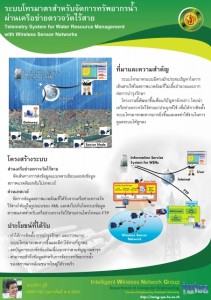Developer:
Patra Poome
Type:
Undergradated
Abstract:
Installation of sensors to measure water-related data such as water level, flow velocity, or riverbank collapse environment is usually done by connecting all the sensors with wires. However, wiring becomes impractical for difficult-to-reach equipment such as two sensors deployed on both sides of a river. Furthermore, electrical disruption at some certain point in the wiring system will cause considerable data losses in most of the area.
This project adopts wireless sensor networks to resolve the above problems by deploying wireless sensor nodes which communicate wirelessly in certain locations. A wireless sensor node is a small device consisting of a central processor unit, various sensors and wireless communication module. It is powered by either batteries or solar energy so that traditional wiring is no longer necessary. To collect environmental data, wireless sensor nodes are programmed to periodically sense the environment and collaboratively relay the data to the data processing center in a multi-hop fashion. Hence deployment of the system becomes much more convenient and losses of data can also be prevented from absence of main power or broken wires.
The experimental results in a small-sized wireless sensor network with a typical measurement frequency show that the system can collect measurement data correctly as expected. In addition, the system is able to adapt, in a timely manner, to topology change caused by installing new sensor nodes into the network.
Progress:
100%





